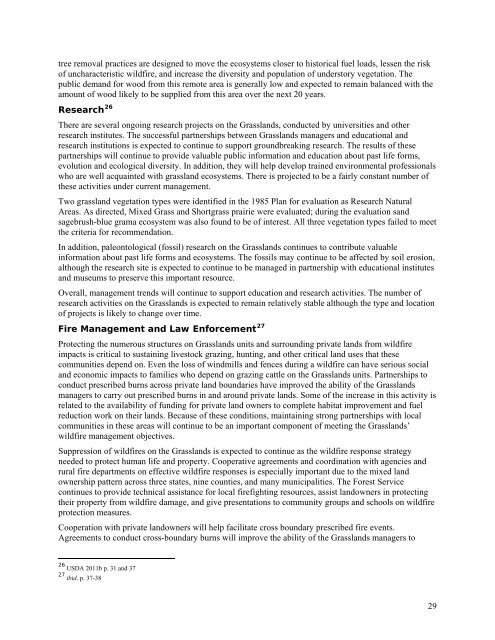Comprehensive Evaluation Report
Comprehensive Evaluation Report
Comprehensive Evaluation Report
You also want an ePaper? Increase the reach of your titles
YUMPU automatically turns print PDFs into web optimized ePapers that Google loves.
tree removal practices are designed to move the ecosystems closer to historical fuel loads, lessen the risk<br />
of uncharacteristic wildfire, and increase the diversity and population of understory vegetation. The<br />
public demand for wood from this remote area is generally low and expected to remain balanced with the<br />
amount of wood likely to be supplied from this area over the next 20 years.<br />
Research 26<br />
There are several ongoing research projects on the Grasslands, conducted by universities and other<br />
research institutes. The successful partnerships between Grasslands managers and educational and<br />
research institutions is expected to continue to support groundbreaking research. The results of these<br />
partnerships will continue to provide valuable public information and education about past life forms,<br />
evolution and ecological diversity. In addition, they will help develop trained environmental professionals<br />
who are well acquainted with grassland ecosystems. There is projected to be a fairly constant number of<br />
these activities under current management.<br />
Two grassland vegetation types were identified in the 1985 Plan for evaluation as Research Natural<br />
Areas. As directed, Mixed Grass and Shortgrass prairie were evaluated; during the evaluation sand<br />
sagebrush-blue grama ecosystem was also found to be of interest. All three vegetation types failed to meet<br />
the criteria for recommendation.<br />
In addition, paleontological (fossil) research on the Grasslands continues to contribute valuable<br />
information about past life forms and ecosystems. The fossils may continue to be affected by soil erosion,<br />
although the research site is expected to continue to be managed in partnership with educational institutes<br />
and museums to preserve this important resource.<br />
Overall, management trends will continue to support education and research activities. The number of<br />
research activities on the Grasslands is expected to remain relatively stable although the type and location<br />
of projects is likely to change over time.<br />
Fire Management and Law Enforcement 27<br />
Protecting the numerous structures on Grasslands units and surrounding private lands from wildfire<br />
impacts is critical to sustaining livestock grazing, hunting, and other critical land uses that these<br />
communities depend on. Even the loss of windmills and fences during a wildfire can have serious social<br />
and economic impacts to families who depend on grazing cattle on the Grasslands units. Partnerships to<br />
conduct prescribed burns across private land boundaries have improved the ability of the Grasslands<br />
managers to carry out prescribed burns in and around private lands. Some of the increase in this activity is<br />
related to the availability of funding for private land owners to complete habitat improvement and fuel<br />
reduction work on their lands. Because of these conditions, maintaining strong partnerships with local<br />
communities in these areas will continue to be an important component of meeting the Grasslands’<br />
wildfire management objectives.<br />
Suppression of wildfires on the Grasslands is expected to continue as the wildfire response strategy<br />
needed to protect human life and property. Cooperative agreements and coordination with agencies and<br />
rural fire departments on effective wildfire responses is especially important due to the mixed land<br />
ownership pattern across three states, nine counties, and many municipalities. The Forest Service<br />
continues to provide technical assistance for local firefighting resources, assist landowners in protecting<br />
their property from wildfire damage, and give presentations to community groups and schools on wildfire<br />
protection measures.<br />
Cooperation with private landowners will help facilitate cross boundary prescribed fire events.<br />
Agreements to conduct cross-boundary burns will improve the ability of the Grasslands managers to<br />
26 USDA 2011b p. 31 and 37<br />
27 ibid. p. 37-38<br />
29
















